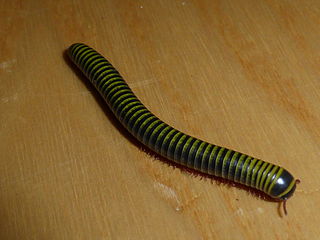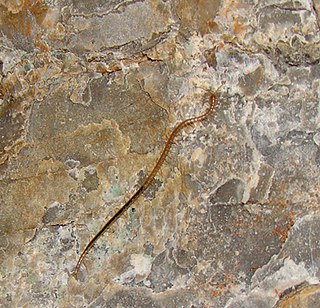
Myriapodology is the scientific study of myriapods which includes centipedes and millipedes. The field of myriapodology can also cover other myriapods such as pauropods and symphylans. Those who study myriapods are myriapodologists.

Sphaerotheriida is an order of millipedes in the infraclass Pentazonia, sometimes known as giant pill millipedes. They inhabit Southern Africa, Madagascar, South and Southeast Asia, Australia and New Zealand. Like the Northern Hemisphere pill millipedes of the order Glomerida, these millipedes can roll into a ball when disturbed. When they are rolled-up, most sphaerotheriidans reach a maximum size of a cherry or golf ball, but some species from Madagascar can even reach the size of an orange. When rolled-up, predators are unable to unravel giant pill millipedes since the margins of their second and last dorsal plates fit perfectly into one another, creating a sealed ball. A few giant pill millipede species are able to produce sound, the only millipedes known to do this. This order of millipedes is also unique in that some African species are used for medicinal purposes.
Mardonius is a genus of giant African millipedes in family Spirostreptidae, containing nine species:

Julidae is a family of millipedes in the order Julida, containing more than 600 species in around 20 genera. Its members are largely confined to the Western Palaearctic, with only a few species extending into the Oriental and Afrotropical realms. They are united by a characteristic form of the mouthparts, and are classified in the superfamily Juloidea of the order Julida, alongside the families Trichoblaniulidae, Rhopaloiulidae and Trichonemasomatidae.
Antichiropus is a genus of millipede in the family Paradoxosomatidae. The genus is very distinctive in the form of the gonopod, which is typically coiled through at least a full circle. It is probably endemic to Australia. Some species have small ranges of less than 10000 km2, classifying them as short-range endemic invertebrates.

Zephroniidae is a family of giant pill millipedes in the taxonomic order Sphaerotheriida. They occur in southeast Asia from the Himalayas and China south and east to Sulawesi and to Australia, and also inhabit some Philippine islands.

Rhinocricidae is a family of millipedes, that occurs disjunctly in Malesia and neighbouring parts of Australasia and in the Neotropics. The family contains the following genera:

Orthomorpha is a genus of millipedes in the family Paradoxosomatidae containing approximately 50 species distributed in Southeast Asia.

Chordeumatida is a large order of millipedes containing some 1200 species with a nearly worldwide distribution. Also known as sausage millipedes, they grow and develop through a series of moults, adding segments until they reach a fixed number in the adult stage, which is usually the same for a given sex in a given species, at which point the moulting and the addition of segments and legs stop. This mode of development, known as teloanamorphosis, distinguishes this order from most other orders of millipedes, which usually continue to moult as adults, developing through either euanamorphosis or hemianamorphosis.

Geophilus is a large, heterogeneous genus of soil centipedes in the family Geophilidae largely considered to be synonymous with Brachygeophilus. The generic name first appeared in Brewster's Edinburgh Encyclopaedia in 1814 as Geophilus electricus. This genus has a Holarctic distribution.
Akamptogonus is a genus of flat-backed millipedes in the family Paradoxosomatidae. There are about 11 described species in Akamptogonus.

Trigoniulus is a genus of millipede in the family Trigoniulidae. There are at least 90 described species in Trigoniulus.

Spirobolellidae is a family of millipedes in the order Spirobolida. There are about 11 genera and more than 100 described species in Spirobolellidae.

Iulomorphidae is a family of millipedes in the order Spirostreptida. There are about 11 genera and more than 60 described species in Iulomorphidae.

Heterocladosoma bifalcatum is a common species of millipede found in eastern Australia.

Zoosphaerium is a genus of giant pill millipedes endemic to Madagascar. Some species within this genus express island gigantism. The largest of the known species of giant pill millipede known is Zoosphaerium neptunus, which is capable of growing to lengths of 90 mm.

Cryptops sometimes known as cave centipedes, is a centipede genus in the family Cryptopidae; species records have a world-wide distribution.

Ribautia is a genus of centipedes in the family Geophilidae. This genus was described by French myriapodologist Henry Wilfred Brolemann in 1909. Centipedes in this genus are found in South America, tropical Africa, Madagascar, the Arabian peninsula, Australia, New Zealand, and Melanesia.
Sechelleptus is a genus of millipedes in the family Spirostreptidae. The genus is found within the East African Indian Ocean islands, including Madagascar, The Seychelles, Mauritius, the Comoro Islands, and Unguja. It contains the following species:
Devillea is a genus of flat-backed millipedes in the family Xystodesmidae. These millipedes are rare and limited to caves. Species in this genus are found in Sardinia, Capri, and southern France in the Maritime Alps. These species are notable for featuring more than the 20 segments usually found in the order Polydesmida. This genus is one of only two genera in this order to feature these extra segments and the first such genus to be discovered.














